

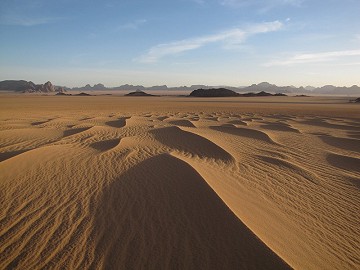
|
Eastern Tibesti, Chad, November, 2024
|
The rock art sites of the Ouri plain along the Eastern side of the Tibesti mountains rank among the most important in the Sahara, yet they have only been visited by a handful of people in the past 50 years (despite their discovery already in the nineteen thirties). The paintings depict mainly cattle and human figures in a very refined style. They have been inaccessible for the best part of the past 50 years, however there was a brief window of opportunity in the past decade, when we made the initial exploration of the area in 2015 and 2017, visiting the most important sites, and already making some new discoveries. The recent upsurge of the rebellion in the Tibesti closed off the area again, but things appear to have calmed down again, in November 2022 we made the approach via the much easier eastern route (from Faya via Gouro), gaining access to the hitherto unvisited norther part of the plain.
This time we plan to re-trace the tried and tested eastern approach via Gouro, and spend 9-10 days on the plain, visiting the principal highlights, plus spending some time exploring the unsurveyed areas in the hope of findng some more unreported sites.
To prepare for the trip, there is now a comprehensive publication covering the full range of sites on the plain and the immediate surroundings:
There are also the early publications on these sites, which were discovered by Francois d'Alverny, a French officer in the period 1934-1936. Alverny's notes were only published posthumously in 1950, and the sites had to be re-discovered in 1993-94 by the expeditions of Adriana Ravenna, Sergio Scarpa Falce, Aldo & Donatella Boccazzi. The finds have been published in the Cahiers de l'AARS and Sahara. d'Alverny's 1950 account and the Cahiers articles are available online as pdf files:
Francois d'ALVERNY (1950), Vestiges d'art rupestre au Tibesti oriental, Journal de la Société des Africanistes, Vol. 20, No. 2, pp: 239-272
Adriana RAVENNA, Sergio SCARPA FALCE, Donatella e Aldo BOCCAZZI (1996), Le pitture della conca di Ouri e dell'enneri Korossom (Tibesti orientale ), Cahiers de l'AARS, No. 3.
Adriana RAVENNA, Sergio SCARPA FALCE, Donatella e Aldo BOCCAZZI (1998), Le pitture del Tibesti orientale, Cahiers de l'AARS, No. 4.
Since Issue 6 (1994) an article was published almost every year by Adriana Ravenna, Sergio Scarpa Falce, Aldo & Donatella Boccazzi in Sahara on individual shelters, the observed styles and the relative chronology of the rock art of the Ouri region.
To receive a "feel" of the trip style and what to be expected along the way and at the Ouri plain, please have a look at the November 2022 trip account. Click here to download Google Earth file (kmz) with waypoints of places mentioned below, to be able to follow the planned route.
Day 0. – Arrival to N’Djamena
At present there are four options, Air France (via Paris CDG), Turkish Airlines (via Istambul), Egyptair (via Cairo) and Ethiopian Airlines (via Addis Ababa), though this may change till the planned dates. Air France and Turkish arrive to N’Djamena in the late evening, Egyptair and Ethiopian during the day. In any case, we will spend one night in N’Djamena a the Hotel Irrisor (former Ibis).
Days 1-3. – N’Djamena - Faya
All paperwork should be completed in the morning, we should be able to depart at around 8am all things going well. We will spend 3 days driving up North along the rather dull and dusty Bahr el Ghazal, then across the Bodélé desert and the Erg Djourab, camping at suitable spots wherever nightfall nears.
Day 4-6. – Faya to Ouri Plain via Gouro
Provided all things go to plan, we should be able to reach the Ouri Plain from Fada in two and a half days, with the first night in Gouro. We will enter the plain in the North, via the Ouri Sao.
Day 7-15. - Ouri plain
If no delays along the way, we will have nine full days to spend on the plain. We weill start in the north, visiting the Mossei area, then drift south via Ouri to Enneri Araské, Enneri Borou, Enneri Borboré, to the Enneri Fofoda area, where there are a number of unexplored regions both along the eastern and western edges of the plain.
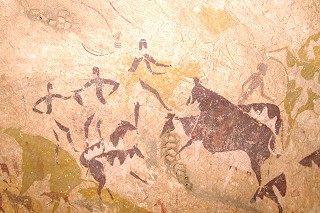
|
FOFODA The shelter of Fofoda was discovered by d'Alverny in October 1934, and it was this site that propted him to begin surveying the area for more rock art sites over the subsequent two years. The shelter contains some very fine groups of cattle and humans in the Karnasahi style, and contrary to many sites in the area it is in an excellent state of preservation. |
|
In 1997 a major new discovery was made by Aldo & Donatella Boccazzi, with hundreds of human and cattle figures in the finest Karnasahi style on an exposed vertical rock face a few kilometres from the original site noted by d'Alverny. There are several more lesser sites in the immediate area. |
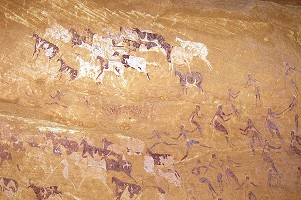 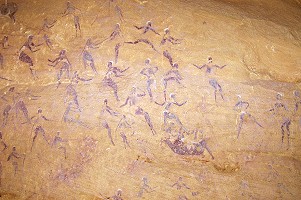 |
We will continue to the suthern part of the plain, visiting the Enneri Daobou and Karnasahi areas. East of Karnasahi there are further unexplored areas to survey if we have enough time left.
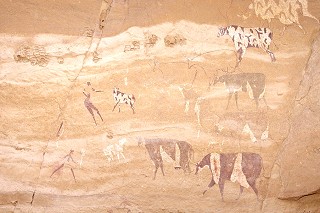
|
KARNASAHI This is one of the orignal sites discovered by d'Alverny in November 1935, and the name was used by Paul Huard to name the peculiar style of paintings found in the entire Ouri region, of which the Karnasahi shelter contains some of the best examples. |
|
The Karnasahi painntings are executed in a very elegant and refined style, with much attention given to the details.of the human figures. The humans are accompanied by similarly well executed cattle, clearly incicating a pastoral society. The quality of paintings rank the Karnasahi style among the finest cattle pastoralist paintings in the sahara, alongside those at Iheren & Sefar in the Tassili and the ones at Jebel Uweinat. The actual Karnasahi shelter only contains relatively few figures, but of an excellent quality. There are several other shelters nearby with the same style of paintings, including the double shelter at Tcherughé which contains a unique milking scene, something surprisingly rare among Saharan pastoralist paintings. |
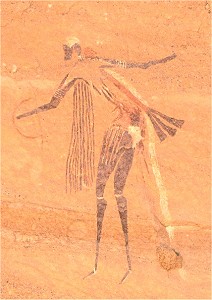 |
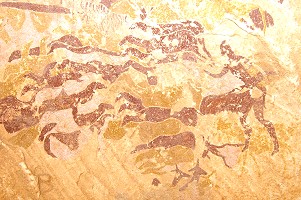 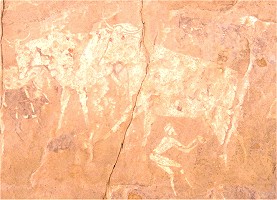 |
Most of the site visits will be with cars (most are approachable to within a couple of hundred metres at most), the only longer walks will be when we go exploring, or possibly to visit the Korossom Timmy site walking up a few kilometres in the Enneri Korossom from the farthest point accessible with cars.
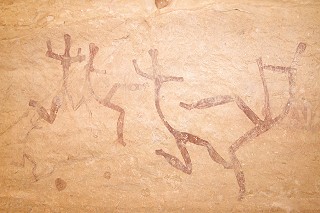
|
KOROSSOM In 1949 a major site was found by Capitaine Schleibing along the Enneri Korossom (leading up to the village of Aozi). It was named Korossom Timmy after the solitary palm tree (in Teda language "timmy") nearby. It contains a series of human figures from a hunter society that pre-date the more common catte pastoralist scenes, which d'Alverny already noted at Fofoda. |
|
In the vicinity a number of other shelters were discovered in the nineties, some containing many more of these figures, accompanied by a number of strange quadriped animals with a very indistinct head, characteristic of these type of paintings, named "Korossom fantastic" by Ravenna & Boccazzi. They represent the earliest period of paintings in the area. Other shelters in the area contain many Karnasahi style paintings, and a unique scene with several extremely finely and delicately drawn camels with associated humans, one of the finest known paintings from the camel period in the entire Sahara (in stark contrast to the usually crude execution observed elsewhere). |
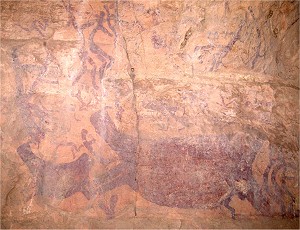 |
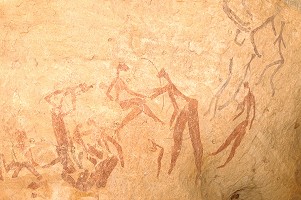 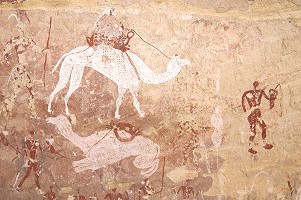 |
Day 16-18. - Return via Gouro to Fada
A two and a half day drive back to Fada along the same route we have taken via Gouro.
Day 19-21. - Faya – N’Djamena
Another 3 day drive back to N’Djamena. With flights leaving late in the night, we will have 2 day-rooms at the Ibis hotel so we can all take a proper shower and change into a more civilized appearance before boarding the flight. Depending on the situation of domestic air services by then, there may be an option to take a flight back from Faya to N'Djamena, saving the dusty three day drive back, but in any case this may not be relied on, only kept open as a possibility.
For information on expected costs, planned dates and any further questions, please send me an email.
Back to planned expeditions...